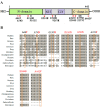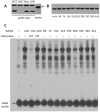Identification of functional mutations in GATA4 in patients with congenital heart disease
- PMID: 23626780
- PMCID: PMC3633926
- DOI: 10.1371/journal.pone.0062138
Identification of functional mutations in GATA4 in patients with congenital heart disease
Abstract
Congenital heart disease (CHD) is one of the most prevalent developmental anomalies and the leading cause of noninfectious morbidity and mortality in newborns. Despite its prevalence and clinical significance, the etiology of CHD remains largely unknown. GATA4 is a highly conserved transcription factor that regulates a variety of physiological processes and has been extensively studied, particularly on its role in heart development. With the combination of TBX5 and MEF2C, GATA4 can reprogram postnatal fibroblasts into functional cardiomyocytes directly. In the past decade, a variety of GATA4 mutations were identified and these findings originally came from familial CHD pedigree studies. Given that familial and sporadic CHD cases allegedly share a basic genetic basis, we explore the GATA4 mutations in different types of CHD. In this study, via direct sequencing of the GATA4 coding region and exon-intron boundaries in 384 sporadic Chinese CHD patients, we identified 12 heterozygous non-synonymous mutations, among which 8 mutations were only found in CHD patients when compared with 957 controls. Six of these non-synonymous mutations have not been previously reported. Subsequent functional analyses revealed that the transcriptional activity, subcellular localization and DNA binding affinity of some mutant GATA4 proteins were significantly altered. Our results expand the spectrum of GATA4 mutations linked to cardiac defects. Together with the newly reported mutations, approximately 110 non-synonymous mutations have currently been identified in GATA4. Our future analysis will explore why the evolutionarily conserved GATA4 appears to be hypermutable.
Conflict of interest statement
Figures




Similar articles
-
GATA4 mutations in 486 Chinese patients with congenital heart disease.Eur J Med Genet. 2008 Nov-Dec;51(6):527-35. doi: 10.1016/j.ejmg.2008.06.005. Epub 2008 Jul 11. Eur J Med Genet. 2008. PMID: 18672102
-
MEF2C loss-of-function mutation contributes to congenital heart defects.Int J Med Sci. 2017 Sep 8;14(11):1143-1153. doi: 10.7150/ijms.21353. eCollection 2017. Int J Med Sci. 2017. PMID: 29104469 Free PMC article.
-
GATA4 screening in Iranian patients of various ethnicities affected with congenital heart disease: Co-occurrence of a novel de novo translocation (5;7) and a likely pathogenic heterozygous GATA4 mutation in a family with autosomal dominant congenital heart disease.J Clin Lab Anal. 2019 Sep;33(7):e22923. doi: 10.1002/jcla.22923. Epub 2019 May 22. J Clin Lab Anal. 2019. PMID: 31115957 Free PMC article.
-
Associations of GATA4 genetic mutations with the risk of congenital heart disease: A meta-analysis.Medicine (Baltimore). 2017 May;96(18):e6857. doi: 10.1097/MD.0000000000006857. Medicine (Baltimore). 2017. PMID: 28471988 Free PMC article. Review.
-
Congenital heart diseases and their association with the variant distribution features on susceptibility genes.Clin Genet. 2017 Mar;91(3):349-354. doi: 10.1111/cge.12835. Epub 2016 Sep 5. Clin Genet. 2017. PMID: 27426723 Review.
Cited by
-
WDR62 variants contribute to congenital heart disease by inhibiting cardiomyocyte proliferation.Clin Transl Med. 2022 Jul;12(7):e941. doi: 10.1002/ctm2.941. Clin Transl Med. 2022. PMID: 35808830 Free PMC article.
-
Mutation Screening of Gata4 Gene in CTD Patients Within Chinese Han Population.Pediatr Cardiol. 2017 Mar;38(3):506-512. doi: 10.1007/s00246-016-1542-0. Epub 2017 Feb 4. Pediatr Cardiol. 2017. PMID: 28161810
-
Absence of GATA4 Mutations in Moroccan Patients with Atrial Septal Defect (ASD) Provides Further Evidence of Limited Involvement of GATA4 in Major Congenital Heart Defects.Eurasian J Med. 2020 Oct;52(3):283-287. doi: 10.5152/eurasianjmed.2020.19237. Eurasian J Med. 2020. PMID: 33209082 Free PMC article.
-
Suppression of canonical TGF-β signaling enables GATA4 to interact with H3K27me3 demethylase JMJD3 to promote cardiomyogenesis.J Mol Cell Cardiol. 2021 Apr;153:44-59. doi: 10.1016/j.yjmcc.2020.12.005. Epub 2020 Dec 24. J Mol Cell Cardiol. 2021. PMID: 33359755 Free PMC article.
-
Towards Understanding the Gene-Specific Roles of GATA Factors in Heart Development: Does GATA4 Lead the Way?Int J Mol Sci. 2022 May 9;23(9):5255. doi: 10.3390/ijms23095255. Int J Mol Sci. 2022. PMID: 35563646 Free PMC article. Review.
References
-
- Bruneau BG (2008) The developmental genetics of congenital heart disease. Nature 451: 943–948. - PubMed
-
- Hoffman JIE, Kaplan S (2002) The Incidence of Congenital Heart Disease. J Am Coll Cardiol 39: 1890–1900. - PubMed
-
- Nemer G, Fadlalah F, Usta J, Nemer M, Dbaibo G, et al. (2006) A novel mutation in the GATA4 gene in patients with Tetralogy of Fallot. Hum Mutat 27: 293–294. - PubMed
-
- Reamon-Buettner SM, Borlak J (2005) Genetic analysis of cardiac-specific transcription factors reveals novel insights into molecular causes of congenital heart disease. Future Cardiol 1: 355–361. - PubMed
Publication types
MeSH terms
Substances
LinkOut - more resources
Full Text Sources
Other Literature Sources
Medical
Miscellaneous

